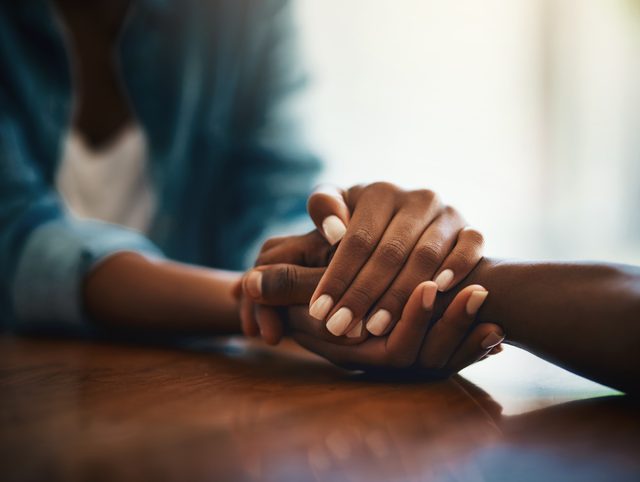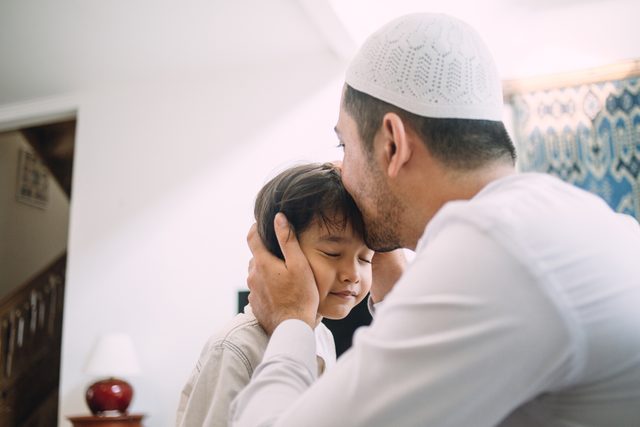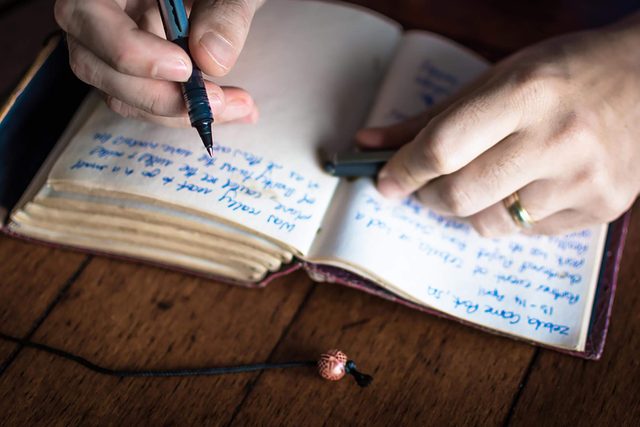
Forgiveness is freeing
Sometimes, it can seem easier to hold onto your anger rather than let it go. “Just because something seems easier at first doesn’t mean it’s the better, more useful thing to do,” says Ilene S. Cohen, PhD, a psychotherapist in Miami, Florida, and co-author of It’s Within You. Being angry is a natural instinct, she says, but it doesn’t always serve you. “I would never push someone to forgive if that’s not what they want to do. However, if they find their anger isn’t helping them, I’d say it’s time to try to forgive, which is also known as resolving unresolved conflict,” she says. Here are the 9 best ways to control anger.

Forgiveness is available to everyone
Most people have someone who’s wronged them in one way or another—be it a parent who neglected them growing up, a spouse who cheated on them in a rocky relationship, or even a person who stood them up on a set of plans. Not all these injustices result in long-lasting emotional upheaval. But when they do, it’s important to know that forgiveness is an option.
“When we’ve been treated deeply unfairly by others, we should have the tools to deal with that so the effects of that injustice don’t take hold in an unhealthy way,” says Robert Enright, PhD, professor in the department of educational psychology at the University of Wisconsin, Madison, and author of Forgiveness is a Choice. What’s more, you don’t need a mental health professional to lead you down the path of forgiveness. It’s something you can achieve on your own, as long as you know which steps to take. (Here’s how to choose a therapist you can trust.)

Decide you want to choose forgiveness
The first step toward achieving forgiveness is deciding it’s something you actually want to do. However, there’s a benefit here for you: Research in the Annals of Behavioral Medicine shows that the act of forgiving decreases one’s perceived level of stress, which is a boon to mental health. “I think it’s important that people are drawn to forgiving—and not forced into it,” says Enright. He also notes that forgiveness doesn’t mean excusing or forgetting an injustice, or returning to a relationship that’s harmful. “Some people misconstrue forgiveness and say, well, if I forgive then I can’t seek fairness,” he says. “That’s one of the big criticisms of forgiveness which is not true.”

Make a list
Start the process of forgiveness with this preliminary step: Make a list of all the people who have hurt you, no matter how small or large, going back to childhood. Next, order the names from the lowest level of injustice and anger to the highest. You’ll start the process of forgiveness with someone toward the bottom of the list. “Starting with the highest person on the list would be like asking someone who’s not physically fit to run a marathon,” says Enright. “Go through the process first with someone who is still bothering you, but it’s also not crushing. As you repeat the process moving higher and higher up the list, you’ll become more forgivingly fit, and better able to face those people who have truly hurt you.” (Want more great advice? These are the 22 secrets your therapist won’t tell you.)

Uncover your anger
This is the official start to phase one of Enright’s forgiveness model, and it’s crucial in reinforcing the importance of forgiveness. “It’s kind of a checklist,” says Enright. “How are you doing in terms of your anger? How have you been denying it? Are you angrier that you thought you were? What are the physical consequences of your anger?” Fatigue is the most common physical complaint Enright hears, as is a pessimistic worldview—believing no one can be trusted or that everyone is only out for themselves. “Once you look at those effects, the question becomes, Do you want to heal?” says Enright. (Here’s how one woman is learning to deal with her anger issues and work towards a happier life.)

See your part in the pain
Speaking of anger, blame tends to go along with it. “It’s important we see the part we play in whatever conflict we are facing,” says Cohen. Skip that step—and see it entirely as the other person’s fault—and the effect will be long-lasting. “Otherwise, you may continue to see the same sort of conflict playing out in other relationships,” she says. Seeing your part in all of this doesn’t mean that it’s now your fault. Your role could mean that you didn’t speak up when something bothered you, for instance, Cohen adds.

Commit to forgiveness
To move toward healing, you’ll want to be fair to those who weren’t fair to you. “Once people have seen how the effects of their anger have made them unhappy, there’s a tendency to give this a try,” says Enright. In this phase, it’s also important to commit to do no harm toward the person you’re trying to forgive. “That doesn’t mean be good to them,” says Enright. “It just means don’t do anything negative.” (Here’s exactly how negative thoughts are aging you faster, according to science.)

Put yourself in their shoes
The goal is to ultimately feel compassion for the other person. Start by thinking about them in a new way. How was that person hurt in life? How were they treated unjustly? Are they so wounded that they wounded you? “That person might have had something going on in their life that you didn’t know about or had a history that contributed to how they acted,” says Cohen. By seeing things from their perspective, you may be able to understand their actions, though this doesn’t mean you have to excuse them. (This woman did just that to cope with the anger and grief from her son’s death—learn more.)

Consider the other person’s humanity
Now that you’ve assessed the person’s woundedness, consider how you share a common humanity. “You were both born, you will both die, you both bleed when you’re cut, you both have unique DNA, and when you die there will never be another person like you,” says Enright. “And given the humanity you share with this person, is it possible that they might be just as special, unique, and irreplaceable as you are?”

Don’t expect something in return
Forgiveness comes from within most of the time, says Cohen. Provided you can safely interact with the person, you might seek out an apology that you don’t get—or it doesn’t feel quite what you wanted. “We don’t always get the apologies we hope for; many people do not take responsibility for themselves and their actions,” she says. That’s why it has to be about doing the inner work on your end, rather than it hinging on a certain reaction from them.

Feel a softening
It could take weeks or even months, but you should begin to feel a change of heart. “When the person’s feelings start to change, that’s the beginning of the unhealthy anger starting to leave,” says Enright. “It’s a tiny glimmering of compassion.”

Bear the pain
Once you’ve begun to feel a softening, the next step is to accept the pain. “We don’t ask people to get rid of the pain,” says Enright, “but to stand with the pain.” That means not passing your pain onto others, in many cases offspring. “It builds self-esteem because you’re saying, ‘If I can see the humanity in the one who didn’t see the humanity in me, and if I can soften my heart to the one who didn’t to me, then who am I as a person? I’m stronger than I thought.'”

Give the person a gift
No, we don’t mean you have to buy them flowers. But Enright does encourage doing something good to the one who hurt you in some creative way or another. “If the person is a danger to you, you don’t have to let them know you’re doing this,” he says. “You can donate some money to a charity in their name, send an email that hasn’t been sent in year, or if you have direct contact, give them a smile or a kind word.” Doing so doesn’t mean you must interact with the person or reconcile, just that you’re willing to do something good to the one who hurt you.

Begin the discovery phase
During a “discovery phase,” you’ll find meaning in what you’ve suffered. “Typically, people are more aware of the wounds in the world,” says Enright. “They become more patient with people who might be having a bad day, they see that people are walking around wounded all the time, and they’re generally more aware of others’ pain and want to be a conduit for good.” And once you have that worldview, you can begin to thrive in life again.

Recognize when you’ve moved on
If you still interact with this person, chances are they’re going to do something all over again. “Many people repeat the same mistakes, and if you can gain an objective perspective and not take their actions personally, then you know you’ve forgiven them,” says Cohen. On the other hand, if they don’t make those mistakes again and you also don’t bring up their past transgressions, that’s another sign you’ve gotten past the problem, she adds.

Give yourself all the time you need
Many people seek to resolve and move past issues from their childhood, says Cohen. “This is a process. It isn’t fixed overnight,” she says. The process isn’t marked by the words “I forgive you” or getting an apology from someone else, adds Cohen, “Forgiveness comes when you can truly see someone in their context and understand their actions from their point of view, no matter how horrible their actions were.” (Here’s how how to apologize with sincerity.)
